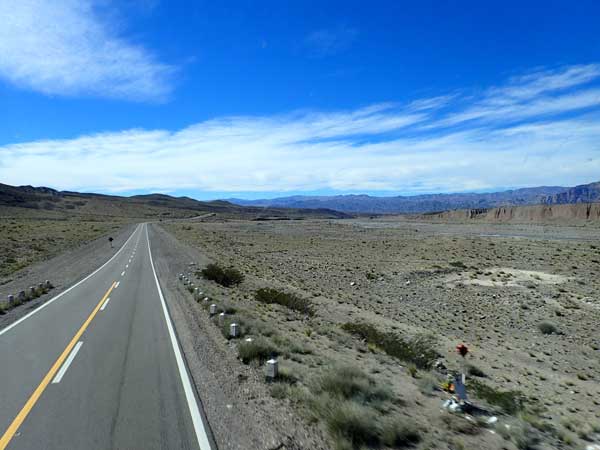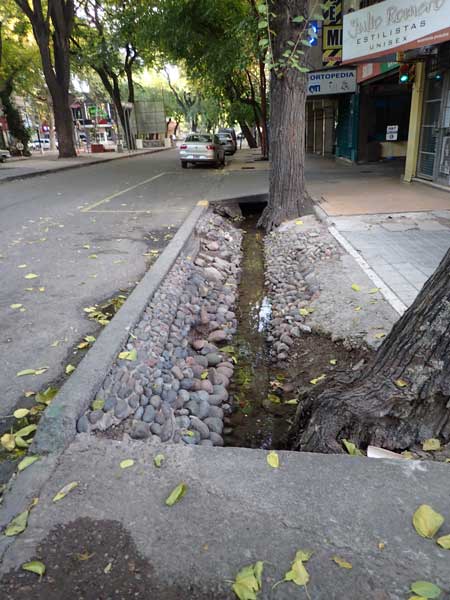Mendoza – a woodland city

Caramor - sailing around the world
Franco Ferrero / Kath Mcnulty
Thu 4 May 2017 01:22
32:53.18S 68:50.38W The overnight coach trip to Santiago went without incident (Nar Bus, not Andesmar, see The Bus to Bariloche, 20 Apr. 2017) and we arrived early. We had just enough time to buy tickets for the 9am bus to Mendoza and grab some food. We jumped on the coach which departed immediately, ten minutes early! The bus headed north out of Santiago along Ruta 5, the main north-south road through Chile. We passed vineyards before climbing into the pre-cordillera, only to head down again to the plain and the town of Los Andes. The autumn colours of the poplars, London planes and vines radiated in the harsh dry sunlight. The bus turned east off the main road and started to climb. We were heading up to the ‘Paso Los Libertadores’, the main pass and border crossing between Chile and Argentina. The Andes are much steeper on the Chilean side and looking ahead, through the window of the coach, I couldn’t work out an obvious route up the sheer slope. A sign appeared “12 hairpin bends ahead”. After three I was feeling giddy …  Hairpin bends knows as ‘Los Caracoles’ (the snails) up to the pass ‘Los Libertadores’ At the top of the pass (3,200m/10,499ft), the vastness of Argentina stretches away into the distance. Our bus descended more gently through a large valley, past stunning scenery. Franco and I were awed by the scale of the landscape. Apparently this is where the film ‘Seven Days in Tibet’ was shot. One problem the filmmakers hadn’t anticipated was the lack of yaks … (I wonder if anyone would have noticed if they had used guanacos instead.) This area is also the training ground for teams hoping to climb Aconcagua, the highest summit outside of the Himalayas. “Hey Franco, we could climb Aconcagua!” “It’s just a walk, you know.” He replied. “A long, cold slog.” (It may be ‘just a walk’, but it takes at least 20 days to get to the summit at 6,062m.)  The road down from the Andes Suddenly we were out of the mountains and on a vast plain. The speed of the transition was surprising.  Looking back towards the Andes We arrived in Mendoza on May Day (Labour Day) so nobody was working. The streets were quiet, the shops shut and most cafés hadn’t bothered opening. The sky was blue and the sunshine hot but the temperature at street level was perfect, in the shade of the thousands of city trees. We wandered around in bliss, soaking up vitamin D.  Leafy avenue Mendoza Province is a desert in the rain shadow of the Andes. It practically never rains, just 213mm per year (a ‘desert’ receives less than 250mm). The natural vegetation consists mostly of spiny prickly bushes. Winter snow on the high Andean mountains slowly melts, trickling into the river beds and cascading down the slopes. This precious water is used to irrigate the crops and vineyards that flourish all around. In recent years, the snow fall has reduced considerably. The city is an oasis of green. Every street has two channels, one running down each side, and together these form an intricate irrigation network. Every few metres, a tree is growing with its roots in the channel. The main species grown are white mulberry, European ash and London plane. Each tree is valued and if a mature specimen starts to lean, feeling the weight of time on its limbs, it is provided with a crutch. If a tree dies, it is replaced with a large seedling. We didn’t see any vandalism to the young trees.  Mendoza from the 7th floor of the city council building  City irrigation channel Although we admired the trees, we dreaded the open ditches. Crossing the road is a hazardous experience. You leave the safety of the broad pavement, negotiate the first drainage ditch, weave a path across two or more lanes of furious traffic, jump the other ditch and stand panting on the far pavement trying to recover composure. (For an insight into Argentinian driving, watch the excellent but horrific Argentinian film ‘Carancho’ – it put us off going to Buenos Aires!) We joked that you wouldn’t want to stagger home drunk for fear of falling into one of the deep trenches and drowning. The lack of drunks on the streets was noted. At a café we listened to people chatting. We were tired, having spent most of the last 24h on buses. “Which country are we in?” Franco asked suddenly. “I could swear they are speaking Italian!” We listened some more. “They’re speaking Spanish with a Neapolitan intonation!” he exclaimed, surprised. The Mendoza accent is different to the Argentinian Spanish we have heard further south. The ‘ll’ is a softer ‘ye’, more like Chile or mainland Spain. Whereas in Tierra del Fuego or Buenos Aires, for example, ‘caballo’ (‘horse’) is pronounced ‘ca-ba-sho’ and the name ‘Guillermo’ (William) is ‘Gui-sher-mo’. This is the pronunciation that gave Ernesto Guevara his ‘nom de guerre’ ‘Che’ Guevara. We checked into the pleasant ‘Square Independencia’ hostel just off the main plaza. For a backpacker’s hostel, the building is rather grand and dates back to more prosperous times.  The inner courtyard at Square Independencia hostel Part of the reason for coming to Mendoza was to go rock climbing nearby, only we had very little information about the crags and were hopeful we would be able to buy the guidebook in town. We set off in search and although all the clues led to the Libreria Technica, the shop assistant sent us on a wild goose chase two blocks further on. Eventually we found one, the first (out of date) edition, but it would have to do. The pedestrianized street Sarmiento with its numerous restaurants vying for customers, seemed a good place for dinner. Our chosen venue was called ‘Na more’ and we wondered what it meant. When the food came, overcooked and stringy, we understood … Never ‘Na more’! Poor show for Argentina’s reputation for meat. The next evening as we strolled by, we noted with interest that the waitress didn’t ask us if we wanted to dine. A couple of nights later we gave Mendoza a chance to redeem itself on the meat front and it excelled.  Avenida Sarmiento  Plaza Independencia  Good rock band in the plaza - the Dennis-the-Menace toddler was helping himself to the takings |